Airfix 1/48 Lightning F.6
|
KIT #: |
A09178 |
|
PRICE: |
$42.99 SRP
|
|
DECALS: |
Three options |
|
REVIEWER: |
Tom Cleaver |
|
NOTES: |
Xtradecal 48-099 “English Electric
Lightning” decals used. |
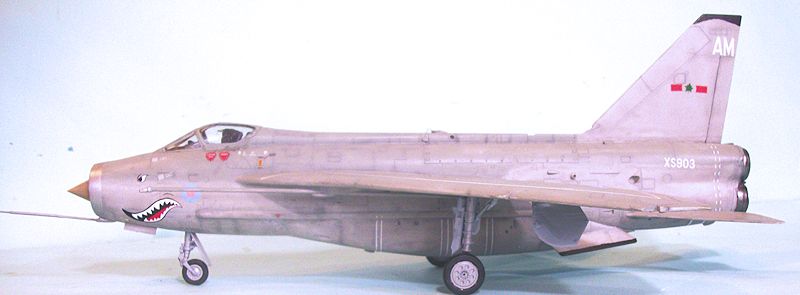
Reading the late great Bill Gunston’s account of the creation of
development of the English-Electric (BAC) Lightning fighter - the only
British-designed supersonic fighter ever to achieve service status - one can
only marvel at the mendacity of British Officialdom.
Shortly after declaring they “had not the heart” to order a pilot to risk
his life in the Miles M.52 attempting the impossible task of supersonic flight,
in 1947 the Air Ministry approved a proposal from designer W.E.W. “Teddy” Petter
for what was in effect a supersonic fighter disguised as an experimental
research program. Thus was born the
ER-103. In 1949, Specification
F23/49 was issued, which allowed the design to have “fighter-like”
maneuverability. Once the project
proceeded, the “boffins” at the Air Ministry and the Royal Aircraft
Establishment were aghast at the design elements: a wing swept back an
incredible 60 degrees, a tailplane set low on the fuselage when everyone knew it
should be a delta shape atop the vertical fin - indeed, such radically wrong
elements would doom the airplane to a fiery future at the end of the first
runway it attempted to fly from.
The program was forced by Those Who Know to have Shorts Aircraft produce the
S.B.5, a “flying scale model” that really wasn’t, then forced it to fly every
other configuration possible (unsuccessfully) before being allowed to fly the
configuration Petter had already committed metal to - which flew perfectly.
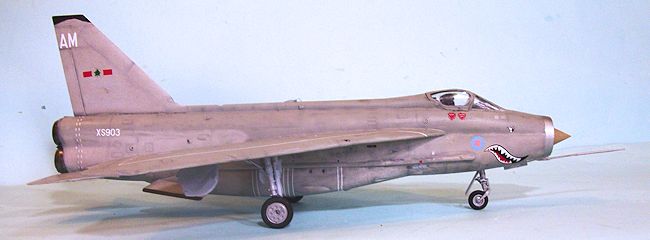 What was then called the P.1, having flown successfully a mere two years
after the F-100 and the MiG-19, survived the tender mercies of Winston
Churchill’s son-in-law Duncan Sandys, who from his deep knowledge of aviation
subjects, decided in 1957 that Britain would skip further development of
soon-to-be-obsolete supersonic airplanes in favor of cheap, easy-to-use and
always-accurate missiles with which to defend the Scepter’d Isle from the
ravening hordes of Commie bombers everyone just knew the evil Commies were busy
producing. Of course, the new
fighter wouldn’t have enough fuel to get from London to Southampton, but then,
it’s traditional for British fighters to be short-legged.
What was then called the P.1, having flown successfully a mere two years
after the F-100 and the MiG-19, survived the tender mercies of Winston
Churchill’s son-in-law Duncan Sandys, who from his deep knowledge of aviation
subjects, decided in 1957 that Britain would skip further development of
soon-to-be-obsolete supersonic airplanes in favor of cheap, easy-to-use and
always-accurate missiles with which to defend the Scepter’d Isle from the
ravening hordes of Commie bombers everyone just knew the evil Commies were busy
producing. Of course, the new
fighter wouldn’t have enough fuel to get from London to Southampton, but then,
it’s traditional for British fighters to be short-legged.
What came out of all this bureaucratic tomfoolery was an airplane so good
pilots everywhere wanted to fly one.
The P.1 achieved supersonic flight on its third flight, and the P.1B
development aircraft achieved Mach 2 on November 25, 1958.
The odd-looking design turned out to be perfectly in accord with the
at-the-time-undiscovered Area Rule.
Placing the engines one above the other on the aircraft centerline meant no
control asymmetry in an engine-out situation.
The Lightning was as fast if not faster than nearly everything else out
there with a top speed approaching Mach 2.3, and could out-maneuver anything
from 35,000 feet on down. It was
the first aircraft capable of supercruise above Mach 1. Its initial acceleration
was so great that the two F2A Lightning-equipped squadrons in West Germany were
based right up on the East German border, tasked with taking off and
intercepting anything crossing the border - a task they accomplished several
times a week for over 25 years.
With a climb rate of 20,000 fpm, the Lightning was truly a world-beater. In
1962, the original F.1A proved itself capable of intercepting U-2s at 65,000
feet.
The Lightning F.6 was the definitive airplane for the RAF, and finally
was allowed to carry enough fuel to be useful, while carrying one
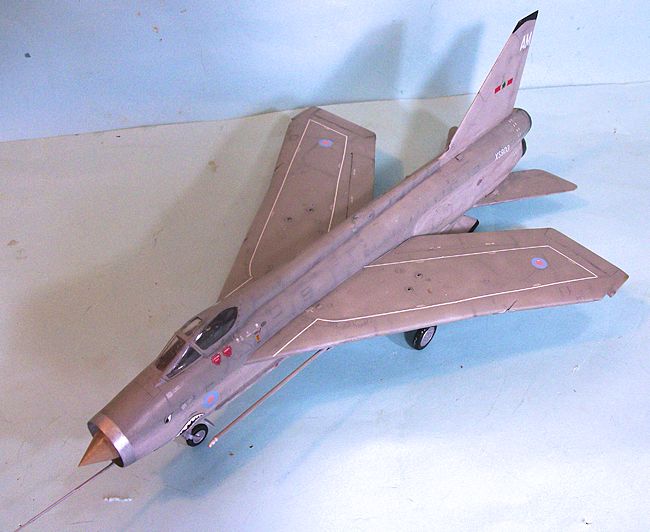 of the
heaviest armaments of any supersonic fighter of the period.
The Lightning F.53 was the ultimate development, which turned what had
originally been a point-defense fighter into an air superiority fighter with
reconnaissance and ground attack capability, which was sold to Saudi Arabia and
served on the front line up until just before the Gulf War, when it was replaced
by the F-15.
of the
heaviest armaments of any supersonic fighter of the period.
The Lightning F.53 was the ultimate development, which turned what had
originally been a point-defense fighter into an air superiority fighter with
reconnaissance and ground attack capability, which was sold to Saudi Arabia and
served on the front line up until just before the Gulf War, when it was replaced
by the F-15.
During a NATO
exercise in 1984, RAF Flt Lt Mike Hale intercepted a U‑2 at 66,000 feet, a
height at which the U-2 had previously been considered safe.
He also climbed to 88,000 ft in Lightning F.3 XR749 in a “ballistic
climb,” taking the aircraft to top speed and then trades speed for altitude.
Additionally, Hale participated in time‑to‑height and acceleration trials
against Lockheed F‑104G Starfighters from the Danish Air Force. The Lightning
won all races easily, except low‑level supersonic acceleration, which was a
"dead heat.” Lightning pilot and Chief Examiner Brian Carroll took a Lightning
F.53 to 87,300 feet over Saudi Arabia at which level "Earth curvature was
visible and the sky was quite dark."
The Lightning’s sole aerial victory came in 1972, when a British Harrier
pilot ejected following engine failure.
The Harrier maintained flight and headed toward the East German border,
and was shot down to avoid a diplomatic incident. During British Airways trials
of the Concorde in April 1985, the airplane was offered as a target to NATO
fighters including F‑15 Eagles, F‑16 Fighting Falcons, F‑14 Tomcats, Mirages,
and F‑104 Starfighters. Only
Lightning XR749, flown by Flt Lt Mike Hale described by him as "a very hot ship,
even for a Lightning", managed to overtake the supersonic airliner on a stern
chase interception.
Group Captain Roland Beamont, chief test pilot on the Lightning, also
flew most of the US "Century series" aircraft.
Nothing at that time had the inherent stability, control and docile
handling characteristics of the Lightning throughout the full flight envelope.
The turn performance and buffet boundaries of the Lightning were well in advance
of anything else available in the West.
The Lightning was fully aerobatic and capable of rates of roll far in
excess of what could be tolerated by a pilot.
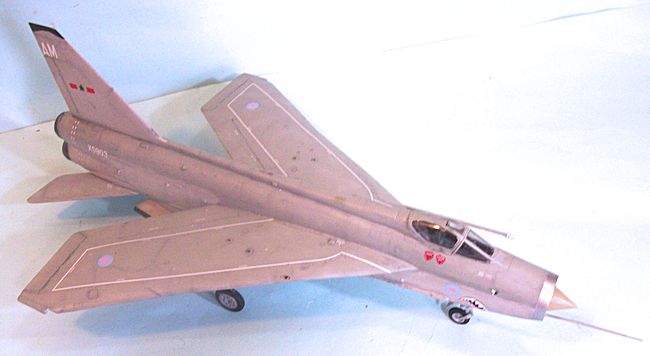 Airfix released two Lightning kits in 1997, the F.1/1A/2A, and the
F.3/F.6. These kits were comparable
in quality to the Spitfire 22/24 and Seafire 46/47 kits, and mark the high point
of “old Airfix.” The kits have been
re-released over the years since.
The most recent incarnation, which is sold as strictly an F.6, in fact has the
necessary parts to create an F.1/1A and 2A if a modeler so desires.
Over the years, the aftermarket has been very nice to this kit, with
Aires releasing an excellent resin cockpit, and Falcon releasing a vacuformed
canopy. In addition, several decal
companies released aftermarket sheets, the two best being from Meteor Decals and
a recent release from Xtradecal. A
sheet from Aeromaster is nice, but the national insignia are not presented in
the correct shades.
Airfix released two Lightning kits in 1997, the F.1/1A/2A, and the
F.3/F.6. These kits were comparable
in quality to the Spitfire 22/24 and Seafire 46/47 kits, and mark the high point
of “old Airfix.” The kits have been
re-released over the years since.
The most recent incarnation, which is sold as strictly an F.6, in fact has the
necessary parts to create an F.1/1A and 2A if a modeler so desires.
Over the years, the aftermarket has been very nice to this kit, with
Aires releasing an excellent resin cockpit, and Falcon releasing a vacuformed
canopy. In addition, several decal
companies released aftermarket sheets, the two best being from Meteor Decals and
a recent release from Xtradecal. A
sheet from Aeromaster is nice, but the national insignia are not presented in
the correct shades.
I don’t know how it is that over the years I failed to put one of these
kits in my collection, but I was able to rectify that earlier this year when
Squadron offered the latest release at 50% off in a special sale.
It was the offer that could not be refused, and the kit duly arrived here
at le Chateau du Chat.
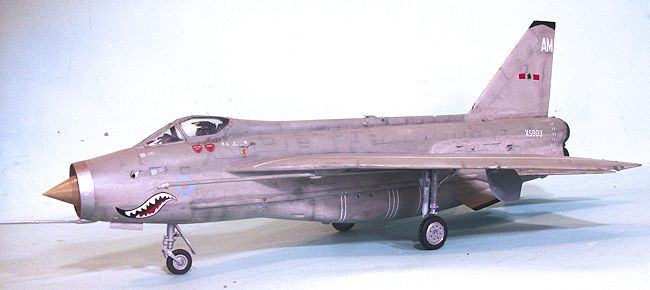 Like most Airfix
kits, construction is the essence of simplicity, and a novice modeler would have
no problem creating a nice model from this.
I opted to do mine totally OOB (since I couldn’t locate an Aires
cockpit). The kit-supplied cockpit
is adequate, and I solved any problem of lack of detail by closing the canopy,
which helps to emphasize the clean lines of the airplane.
Like most Airfix
kits, construction is the essence of simplicity, and a novice modeler would have
no problem creating a nice model from this.
I opted to do mine totally OOB (since I couldn’t locate an Aires
cockpit). The kit-supplied cockpit
is adequate, and I solved any problem of lack of detail by closing the canopy,
which helps to emphasize the clean lines of the airplane.
I only had to use a very little Mr. Surfacer down the centerline of the
fuselage, with all parts fitting as nicely as a modern kit, let alone one from
17 years ago. However, I managed to
spill a bit of Tenax on a lower wing surface, which was sanded down and cleaned
up, but left things in such a state that I decided I would have to go with a
camouflaged Lightning, rather than the NMF airplane I had originally planned.
I decided to use the Xtradecal sheet 48-099 top do Lightning F.6 XS903 of
5 Squadron when based at Binbrook in 1984.
This is a nice air superiority scheme of Camouflage Grey on the lower
surfaces and vertical fin, and Medium Sea Grey on the upper surfaces.
With pre-shading and then applying the c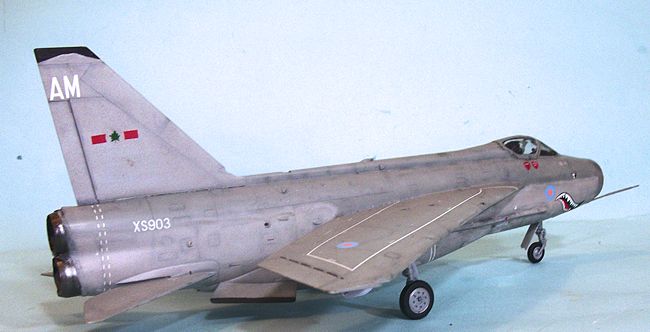 amouflage colors in thinned
coats, I was able to get the “used” look I found in a photograph of this
airplane. Alclad Polished Aluminum
was used for the nose ring.
amouflage colors in thinned
coats, I was able to get the “used” look I found in a photograph of this
airplane. Alclad Polished Aluminum
was used for the nose ring.
The kit decals
were used for stenciling and walkways, with the Xtradecals used for the
markings. The “tiger mouth”
provides a nice bit of color on an otherwise-drab air superiority scheme.
I attached the
landing gear and discovered I had not placed enough weight in the fuselage
during construction to insure nose-sitting.
Several small fish weights were cut in half and squashed thin, then
slipped past the nose cone to hide behind it, providing the necessary margin to
get proper sit.
This kit is still
a gem, and still marks a high point in the history of Airfix even with the new
kits that are being released. I’m
sure I’ll be getting another, to do that super 74 Squadron NMF scheme.
Tom
Cleaver
October 2014
Review kit courtesy of my
wallet. Thanks to Hannant’s for the
review sheet of decals.If you would like your product reviewed fairly and fairly quickly, please
contact
the editor or see other details in the
Note to
Contributors.
Back to the Main Page
Back to the Review
Index Page



 of the
heaviest armaments of any supersonic fighter of the period.
The Lightning F.53 was the ultimate development, which turned what had
originally been a point-defense fighter into an air superiority fighter with
reconnaissance and ground attack capability, which was sold to Saudi Arabia and
served on the front line up until just before the Gulf War, when it was replaced
by the F-15.
of the
heaviest armaments of any supersonic fighter of the period.
The Lightning F.53 was the ultimate development, which turned what had
originally been a point-defense fighter into an air superiority fighter with
reconnaissance and ground attack capability, which was sold to Saudi Arabia and
served on the front line up until just before the Gulf War, when it was replaced
by the F-15.
 Like most Airfix
kits, construction is the essence of simplicity, and a novice modeler would have
no problem creating a nice model from this.
I opted to do mine totally OOB (since I couldn’t locate an Aires
cockpit). The kit-supplied cockpit
is adequate, and I solved any problem of lack of detail by closing the canopy,
which helps to emphasize the clean lines of the airplane.
Like most Airfix
kits, construction is the essence of simplicity, and a novice modeler would have
no problem creating a nice model from this.
I opted to do mine totally OOB (since I couldn’t locate an Aires
cockpit). The kit-supplied cockpit
is adequate, and I solved any problem of lack of detail by closing the canopy,
which helps to emphasize the clean lines of the airplane. amouflage colors in thinned
coats, I was able to get the “used” look I found in a photograph of this
airplane. Alclad Polished Aluminum
was used for the nose ring.
amouflage colors in thinned
coats, I was able to get the “used” look I found in a photograph of this
airplane. Alclad Polished Aluminum
was used for the nose ring.